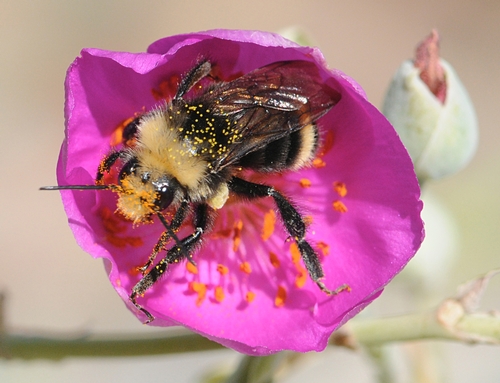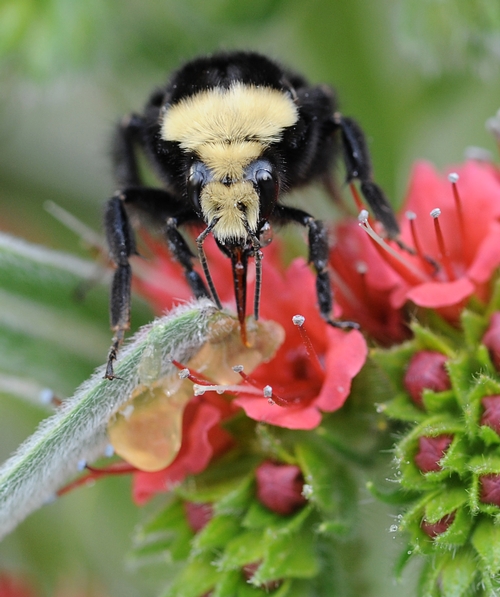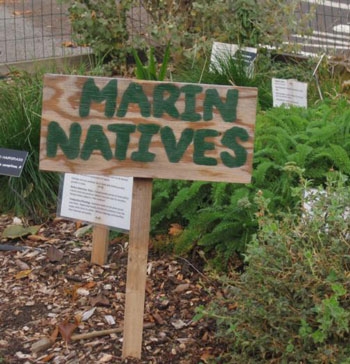From the UC Blogosphere...
C'mon, Native Pollinators
So you want to attract native pollinators to your garden. The Xerces Society for Invertebrate Conservation, based in...

Pollen-Packin' Bumble Bee

Sugar Fix
Novato garden project gets complicated
Developing a community garden in Novato is proving more complicated and costly than expected, but local organizers are pressing forward with their plans, according to an article in the Marin Independent Journal.
The garden, which will contain 50 to 80 garden plots, is proposed by the non-profit organization Novato Live Well Network. Initially, the group thought expenses for the project would amount to $25,000. However, the price tag has swelled to $220,000 to $250,000.
Reasons cited in the article for increased costs include:
- The city of Novato's fiscal problems preclude it from assisting with infrastructure and waiving fees
- Compliance with the Americans with Disabilities Act is making the design more expensive
- North Marin Water District announced a 2009 moratorium on new connections. The Novato Live Well Network found a contractor to help them drill an 80-foot well on the property
Project supporters say the community garden would allow Novato residents to grow their own food and make better nutritional choices. A percentage of plots will be offered to low- or moderate-income households, and plot fees will be charged on a sliding scale. "Community gardens open up the opportunity for community members to garden, and improve health factors, making them more active and getting them to eat more fruits and vegetables," the story quoted Mark Bauermeister, the UC Cooperative Extension Master Gardener coordinator in Marin County. "If they're managed correctly, they can be beneficial for the environment, encourage community interaction and beautify the neighborhood." Late last year, Bauermeister, Marin environmental horticulture advisor Steven Swain and Marin community development advisor Ellie Rilla completed a Marin County Community Garden Needs Assessment. UC Cooperative Extension will host a day-long Community Garden Summit April 29 at San Rafael's Pickleweed Community Center, the article said.

Native plants on display at an existing Marin County community garden.
Now That's Thorny
You never know who's coming to dinner...er...reception. When the UC Davis Department of Entomology hosted an open house...

Meeting a Walking Stick

Close-up
The best agritourism is found on real working farms
The San Diego Union Tribune ran a 1,500-word story on local agritourism last Friday, featuring UC expertise and resources front and center.
UC's agritourism coordinator Penny Leff provided reporter Emily Rizzo with a definition of agritourism, "a commercial enterprise on a working farm or ranch conducted for visitor enjoyment and education that generates supplemental income for owners."
Promoting agritourism in San Diego has been underway for years, but positioning the Southern California city as an agritourism destination, said UC small farm advisor Ramiro Lobo, is a relatively new concept.
In 1993, Taco Bell's founder opened Bell Gardens, a 115-acre educational farm that attracted 100,000 visitors annually to picnic, buy fresh produce and ride a mini-train. The ranch attracted busloads of agritourists but closed in 2003, the article said.
“It was obviously a heavily subsidized operation, but (it) created attention,” Lobo commented. “Entrepreneurial farmers started tapping into this as a real alternative to diversify their income stream.”
San Diego County now has more than 100 self-identified agritourism businesses, Lobo told the reporter.
Leff and Lobo agree that consumers want to visit real agricultural operations and have a keen sense when it comes to discerning hokey operations from working farms.
“You don’t have to create a Disneyland,” Lobo said. “We want working farmers to be able to capitalize on this without having to spend a ton of money to create something artificial. Pseudo-farms, for the most part, never really did a great job. Those have come and gone.”
Among the UC agritourism resources mentioned in the story were:
- The UC California Agricultural Tourism Directory, which highlights farms and ranches to visit and upcoming events, at CalAgTour.org.
- University of California Cooperative Extension in San Diego County

U-pick operations are a form of agritourism.
How to Plan Spuds
By Denise Levine, U. C. Master Gardener
It is time to plant potatoes.
Potatoes belong to the nightshade family, which makes them cousins of tomatoes, eggplant, nicotine and petunias. A dietary mainstay in many peasant cultures, potatoes were considered the food of the gods in ancient Peru. In Napa Valley, they fall somewhere in between.
A single plant can produce two to four pounds of potatoes, so even one plant is worth growing. Try ‘Purple Majesty,’ high in phytonutrients and gorgeous when whipped or mashed; or ‘Rose Finn Apple,’ steamed and adorned with butter and chopped parsley. Or plant large, dry russet types for baking. These fat, fluffy potatoes are great for twice-baking with your family’s favorite toppings.
Potatoes can be successfully planted in the Napa Valley from mid February through June. They like light, friable, well-drained soil, so the typical Napa clay may need some amendments. The tubers can tolerate a wide range of soil pH, but the University of California recommends fertilizing before planting with a 5-10-5 or 10-10-5 mix. Three pounds of fertilizer is enough for 100 square feet of soil.
You can till the fertilizer into your bed or, to apply as a band, dig a furrow about two inches deeper than you'll plant the seed pieces; sprinkle the fertilizer evenly along this furrow and cover with at least two inches of soil before planting.
Because potatoes are relatively shallow rooted, they do best with frequent light irrigation. You may need to water several times a week. Have you ever seen potatoes with little knoblets on the end? They came from a plant that had been watered well and then went into a period of drought. When watering resumed, the potato began to grow again.
Two other potato maladies can usually be avoided with consistent moisture during the growing season. One is potato scab, which looks like brown, scarred skin. The other is "hollow heart," which produces a cavity in the center of the potato.
Be sure to buy certified potato seed. Certified potatoes have been inspected for disease. Local nurseries have a good selection now, but shop soon. As Napa County gardeners dig their potato patches, supplies dwindle.
Some seed potatoes are mini potatoes that can be planted whole. But more often, seed potatoes are normal-sized tubers with several "eyes" or sprouting buds. Before planting them, cut them into smaller pieces, each weighing one-and-a-half to two ounces, and each with at least one or two "eyes." Leave the pieces at room temperature for a day or two to allow the cut area to heal. Your patience will reduce the chance of the potato rotting in the soil before it begins to grow.
To plant, prepare a furrow three inches deep and drop the potato pieces into the furrow, spacing them six to ten inches apart. The amount of room they have will affect how large they can grow, although variety plays a role, too. Do you want giant spuds for twice-baked potatoes, or tiny potatoes for boeuf bourguignon? Space them accordingly. If you plant more than one row, space the rows about three feet apart.
After four to six weeks, you will see green growth in the furrows. Mound three inches of soil on top of the new growth so that the seed pieces are six inches deep. Keep your potato plants weeded, but be careful not to disturb the shallow roots.
Monitor plants for aphids. A water rinse with special attention to the underside of the leaves can keep aphids at bay.
During the growing season, if you are gentle, you can pilfer a few of the baby potatoes for a special meal or guest. But delay the main harvest until after the vines have died back, and the skin of the potato is firm and not flaky. Remove the dead vines, then dig or fork carefully to expose the potatoes.
After you dig your potatoes, store them at room temperature for a week. Then store in a cool, dark area, preferably between 40°F and 50°F. Depending on the variety, they will last up to 10 weeks.
Even if you don’t have a garden, you can grow potatoes. Check your local nursery for potato bags for your deck or patio. These heavy-duty, breathable bags allow you to grow potatoes almost anywhere. Fill the bag with a layer of soil and your potatoes, and as the plants grow, add more soil per directions. You’ll be savoring hot buttered potatoes in no time.
Free Workshop: Napa County Master Gardeners are conducting a seminar on “The Unusuals: Fruits and Vegetables,” on Saturday, February 26, from 9:30 a.m. to 11:30 a.m., at the University of California Cooperative Extension office in Napa (address below). Add fun and interest to your harvest and expand your gardening repertoire by learning to successfully grow uncommon fruits and vegetables. Register online at http://ucanr.org/sites/ucmgnapa/.







